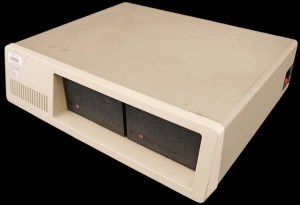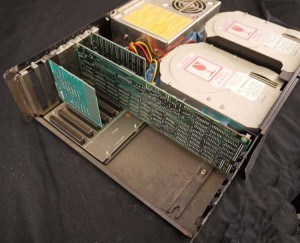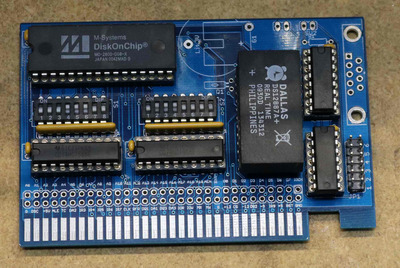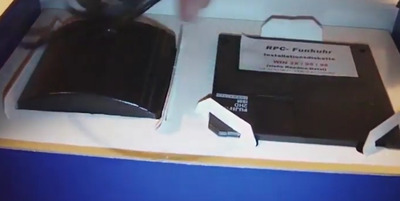Sphere478 wrote on 2022-09-23, 18:20:
I’m trying to determine which of the chips is the cpu?
The 8088 is next to the casette port (the second DIN socket next to the keyboard port.
Sphere478 wrote on 2022-09-23, 18:20:
I see -5 on a few, does that mean 5mhz?
Yes. The IBM PC runs off a single 14.31818 MHz oscillator. This is four times the NTSC color subcarrier frequency and was a very common and cheap crystal at that time. As the 8088 works best when the clock signal is low twice as long than it is high, the system clock is generated using a divide-by-3 circuit (usually the purpose-built Intel 8284 clock generator circuit), resulting in 4.77 MHz. This clock is used as processor clock, chipset clock and ISA bus clock. It's used to drive the timer chip, too. As all the chips are clocked as just below 5MHz, using the "up to 5 MHz" version of these chips is perfectly fine. The same 14.31818MHz clock also directly drives the CGA pixel frequency. As the frequency is a multiple of the NTSC color subcarrier, the CGA can can use it to drive its mediocre NTSC color generation circuit for the composite output from it. IBM made the 14.318 MHz signal available in the ISA bus so they could save the board space and cost of a dedicated oscillator on the CGA card.
Sphere478 wrote on 2022-09-23, 18:20:
In which case a 16mhz would be nice, but did those have multipliers or did the entire system have to bump its speed to 16 mhz? I gotta imagine the rest of those ancient chips may not like it.
It is quite common to push the IBM design to 10 MHz using chips with a higher speed grade and adding a wait state on the ISA bus. This design is called "Turbo XT". The actual mainboard technology didn't change much between the PC and the XT. Main differences are that the slots are spaced closer, allowing 8 slots instead of 5, support for newer RAM chips allowing more onboard memory and the removal of the cassette port. The most prominent feature of the XT, the possibility to install a hard drive, was not due to a main board change, but due to a more powerful power supply equipped in the case. When the 10MHz machines were arising, the PC and its clones were already replaced by XT clones.
10 MHz is the highest official speed available of the 8088 chip, that's why no faster XT designs got common. Also, the XT design suffered severely from the limited bandwidth of the 8088 bus interface. The 8086 had twice the bus performance, and the 80286 and quadruple the bus performance at the same clock, so instead of trying to push the last out of the 8088 design (there were faster versions of the NEC V20), manufacturers instead started making AT clones that provided considerably more bang for the buck.
Sphere478 wrote on 2022-09-23, 18:20:
Did they have math coprocessors yet back then? Those other chips are just the chipset I am thinking?
The 8087 coprocessor was an optional upgrade that can be installed in the empty socket next to the keyboard port.
Typically, the term "chipset" is used for combinations of two to five highly integrated chips that contain mostly all of the chips of the PC main board, but are more compact and allow for more stuff (parallel/serial ports, video) being placed on the main board along the basic system control functions. The term chipset is also used for single-chip solutions, although calling them a chipset is a little stretch of the name. Single-Chip XT solutions (just add the processor, the BIOS and RAM as extra chips) were nevertheless common at the end of 80s. So essentially these other chips do what a chipset does, but it was not called "chip set" back in the day.
Sphere478 wrote on 2022-09-23, 18:20:
Raising the isa bus clock on a system with ram on the isa would be a good idea if you can do it stable.
The concept of a separate ISA clock is newer than the PC. In the PC, the ISA bus is fast enough to not add extra wait states to the 8088 memory and I/O cycles. The concept of having the ISA clock separated from the processor clock came up around the time of 12 and 16 MHz 286 machines, because ISA cards would fail to operate properly at the processor clock.
In case of the IBM PC, you would first need to split the single clock source into two sources: One clock driving the processor and the bus (which you would increase for higher performance) and a second clock driving the CGA pixels and the timer chip (which needs to be based on the classic 14.318 MHz crystal). That's what Turbo-XT boards do, but can't be done easily on the classic PC/XT boards.
Bottom line: If you want to mess around with the processor speed, don't start below Turbo-XT boards. The 5150 and 5160 are designed in a way that makes overclocking near impossible if the system time, the PC speaker beep frequency and CGA/EGA video timings should not be affected.




